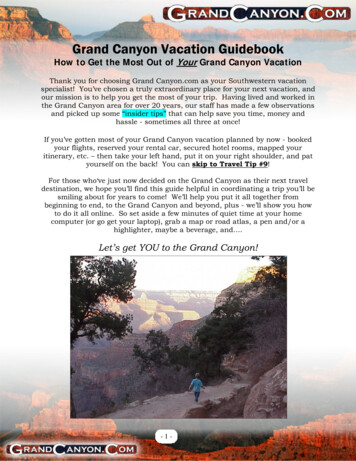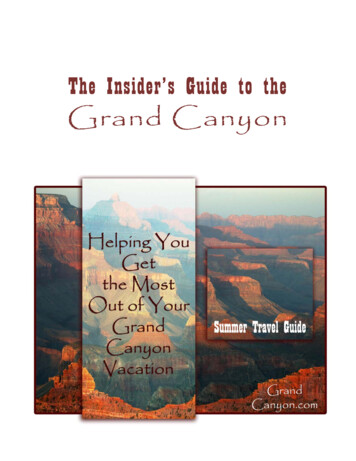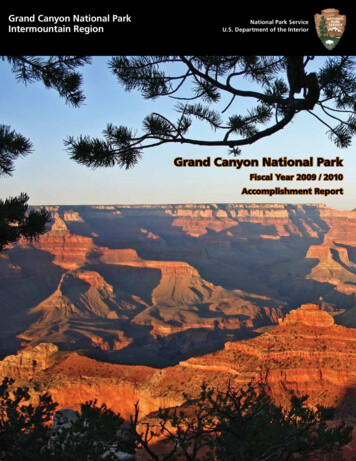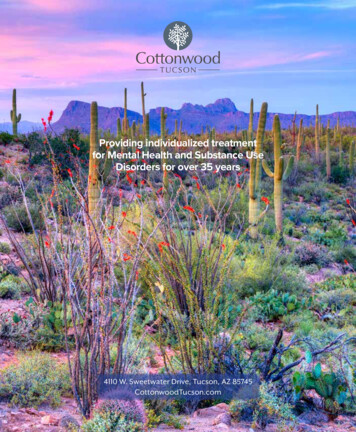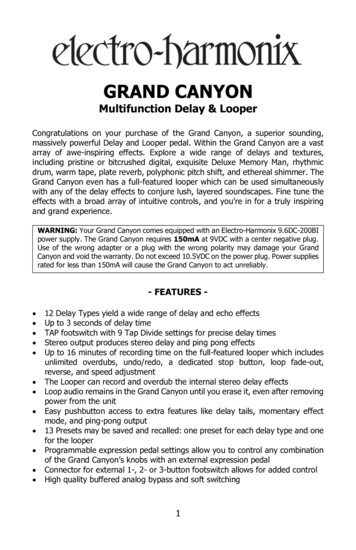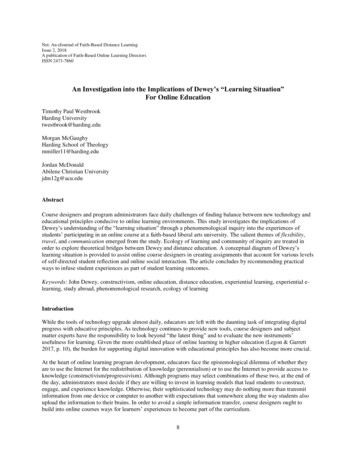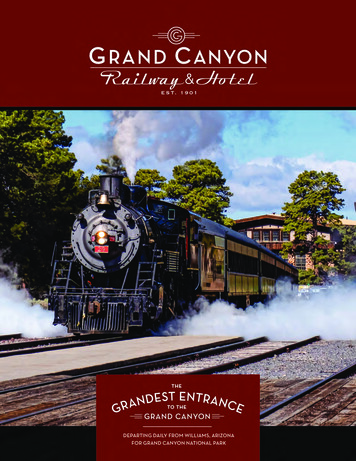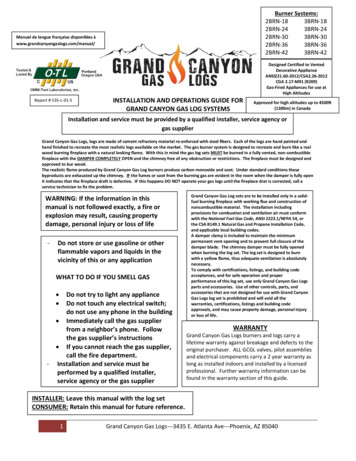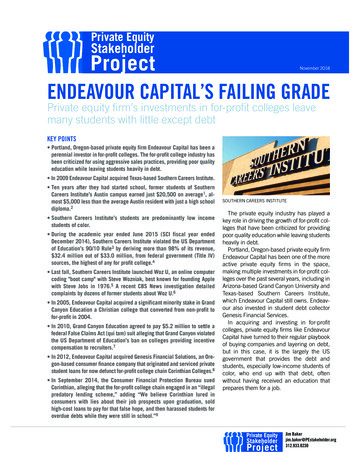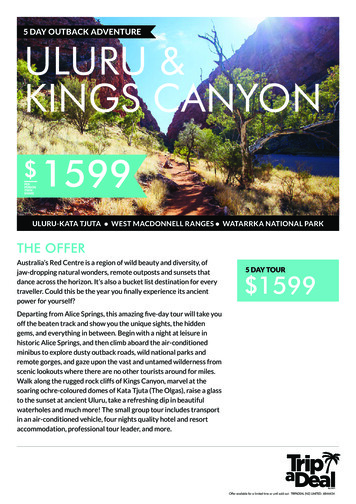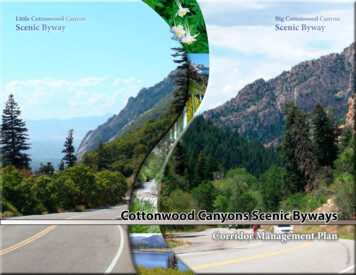
Transcription
Little Cottonwood CanyonScenic BywayBig Cottonwood CanyonScenic BywayCottonwood Canyons Scenic BywaysCorridor Management Plan
Cottonwood CanyonsCorridor Management Plan2008Project Team:Carol Majeske, US Forest ServiceClaire Runge, Town of AltaBarbara Cameron, Big Cottonwood Canyon Community CouncilLaura McIndoe Briefer, Salt Lake City Public UtilitiesRitchie Taylor, Utah Department of TransportationPeter Jager, Utah Department of TransportationPrepared for:Cottonwood Canyons Scenic Byways CommitteePrepared by:Fehr & Peers2180 South 1300 EastSalt Lake City, Utah 84106p 801.463.7600MGB A145 West 200 SouthSalt Lake City, Utah 84101p 801.364.9696HW Lochner310 East 4500 SouthSalt Lake City, Utah 84107p 801.262.8700ADOPTED DECEMBER 2008Page 2 � Cottonwood Canyons Corridor Management Plan
Contents1Introduction52Travel Conditions along the Byways93Intrinsic Qualities194Byway Issues275Vision316Goals and Strategies337Byway Specific Plans378Implementation65Cottonwood Canyons Interpretive PlanCottonwood Canyons Corridor Management PlanPage 3Page 3
xPage 4 � Cottonwood Canyons Corridor Management Plan
Chapter 1 : IntroductionA Corridor Management Plan is a written plan developed by the communities and stakeholders in abyway area that outlines how to define and enhance the byway’s intrinsic qualities and character.Utah is a state of contrast, where red rock gorges meet snow capped peaks. Among the most scenic and visitedlocations in the state, the Wasatch Mountains in northern Utah are a collection of special places that draw residentsand visitors in quantity. At the base of these mountains, the Wasatch Front region is home to thousands of outdoorenthusiasts, many of whom choose to live in the Salt Lake City region for its abundant recreation opportunities. Inpast years, the population has boomed and now is home to approximately twoSalt Lake Internationalmillion residents. In the heart of the Wasatch Mountains are Big and Little CotAirporttonwood Canyons. Over one million people live within a 30 minute drive fromthese Canyons. The airport is 30 minutes away, as is downtown Salt Lake City.These Canyons are a marvel of accessibility, and they are loved by residents andvisitors.Given the close proximity to a major population center, Big and Little Cottonwood Canyons draw millions of visitors each year; peak days can generate over10,000 vehicles in each canyon. There exists a fine balance between visitors andenvironment. Mountain run-off provides drinking water for the metropolitanarea below, and Big and Little Cottonwood Canyons must be managed for thehealth of the watershed. This challenge has been addressed by a highly functioning multi-jurisdictional team, all with the charge to protect the vital ecosystem while maintaining recreational opportunities and local economies thathave existed since the turn of the century.to Big CoCanyon S ttonwoodcenic Bywayto LittleCoCanyon S ttonwoodcenic BywayCottonwood Canyons Interpretive PlanPage 5Cottonwood Canyons Corridor Management PlanPage 5
Two distinct roadways, Big Cottonwood Canyon Road, or SR-190, and LittleCottonwood Canyon Road, or SR-210, provide access to the Town of Alta, fourski resorts, and numerous Forest Service recreation sites, as well as homes andbusinesses. Both roads are state highways with operation and maintenanceunder the jurisdiction of the Utah Department of Transportation (UDOT). In1990, SR-190 and SR-210 were designated as State Scenic Byways, though noScenic Byways planning or projects had been conducted to date. The criticaltheme of watershed inevitably ties these two Byways together with a uniquecommonality found very rarely in the Scenic Byways program. For this reason,and their adjacency, this Corridor Management Plan addresses both Byways,however, unique opportunities for each are presented.Because both roads are State Scenic Byways, funding through the NationalScenic Byway Program is available to study issues and prepare a long termguidance document. Under the National Scenic Byway Program, a local agencymust coordinate this planning effort and administer any resulting projects.The Town of Alta, with assistance from the United States Forest Service (USFS),prepared a grant application for funding for this Corridor Management Plan(CMP) and Interpretive Plan (IP). The grant was approved in 2005; with matching funds provided by USFS, UDOT, the Town of Alta, Salt Lake County, Salt LakeCity Department of Public Utilities, Alta Ski Lifts, Snowbird Corporation, andthe Big Cottonwood Canyon Community Association. The results of this studyis a Corridor Management Plan and an Interpretive Plan for each Byway. Thestudy also includes a recommendation, driven by the stakeholders, whether ornot to pursue National Scenic Byway designation. The National Scenic BywaysProgram is focused on recognizing special roadways in America, and does notimpose any regulation.A CMP is a written plan developed by the communities and stakeholders ina byway area that outlines how to define and enhance the byway’s intrinsicqualities and character. The plan typically addresses issues such as: tourism,historic and natural preservation, roadway safety, and economic development.The CMP is a guide that addresses issues but does not necessarily offer solutions for every problem. It is important to recognize that a CMP is not a regulatory document, and it is not a substitute and does not supersede existing landand resource management plans. The CMP and IP together simply outline aplan that will protect and enhance the unique qualities of the Byways, and givesound information in an appealing and effective way.Page 6 � Cottonwood Canyons Corridor Management PlanStudy AreaThe study area for the CMP encompasses the entire lengths of both Big andLittle Cottonwood Canyon Roads, located in Salt Lake County. Big CottonwoodCanyon Road (SR-190) is 15 miles long, starting at the mouth of the Canyon andending at the community of Brighton. Little Cottonwood Canyon Road (SR210) is seven miles long, beginning at the mouth of the Canyon and ending atthe Town of Alta. Both similarities and differences draw these Byways togetherand distinguish them. Big Cottonwood Canyon Road and Little CottonwoodCanyon Road are included in this Corridor Management Plan though they areeach separate Byways. Figure 1 shows the study area boundary as well as jurisdictional boundaries and general land use. Because viewshed is an importantquality for Byway travel, the study area extends to the ridge-line since muchof it is visible from the roadway. In addition, the critical issue of watershedin these Canyons is inherently tied to Canyon health, therefore the study areamust extend beyond the roadway to adequately discuss this multi-jurisdictional issue.
LEGENDHolladayMunicipalityMount Olympus Wilderness Area§ 215AltaCottonwood HeightsDraper CityitCoSandy CitymOPHolladayWilderness AreaunOPStudy Area190LakeCreeky waymSuon BCanyddoowoo190ottonBig CtyCottonwood HeightsStructureRoadByan yonaCCddoooo nw oCotteltLitUS Forest ServiceUndeveloped PrivateResidentialwaySa l tAltaWa s at cOPCommercial210TOF UU SEACUtah CountyEST SERVICEFO RDEPARSTATEhT URN OF AHWALTSandy CityCottonwood CanyonsTOUS Forest ServiceLaount y210CoTwin Peaks Wilderness AreaOPLocal RoadkeState RouteuntyInterstateTMENT OF AGRICULLone Peak Wilderness AreaScenic Byways StudyDraper CityTOF UAU ST UREHTOATEDEPARSTScenic Byways StudyWALTCottonwoodCanyonsEST SERVICEN OF AFORTMENT OF AGRICUL00.512Cottonwood Canyons InterpretivePlanMiles345Figure 1 - Study Area,Land Use and Jurisdictional Boundaries1:115,000Cottonwood Canyons Corridor Management PlanOPage 7Page 7
Public and Stakeholder InvolvementPublic involvement efforts for the Corridor Management Plan included anopen house and mobile outreach efforts, as well as an extensive and inclusivestakeholder involvement process. The objectives of the public outreach whereto present elements of the plan, and obtain visioning input.The stakeholder group represented a large cross-section of interests and werean integral part of decision-making for this process. Stakeholders met six timesthroughout the project. At each meeting, they were asked to think criticallyabout issues, solutions, and the future of the Byways. Feedback from thesemeetings creates the fabric from which this CMP is developed. The group consisted of representatives from: Page 8 � Cottonwood Canyons Corridor Management PlanAlta Ski Lifts CompanyBig Cottonwood Canyon Community AssociationBrighton Ski ResortCottonwood Canyons FoundationCity of Cottonwood HeightsFederal Highway AdministrationGranite ConstructionRocky Mountain PowerSalt Lake CitySalt Lake Climber’s AllianceSalt Lake County (Mayor’s Office, Bicycle Advisory Committee,Planning, Sheriff, and Engineering departments)Sandy CitySave Our CanyonsSierra ClubSilver Fork LodgeSnowbird Ski ResortSolitude Mountain ResortUtah State History DivisionThe Church of Jesus Christ of Latter-day SaintsTown of AltaUtah Department of TransportationUnified Fire AuthorityUnited States Forest Service, Wasatch-Cache National ForestUtah Transit AuthorityWasatch Front Regional CouncilWasatch Mountain ClubSalt Lake Convention and Visitors BureauUtah Office of Tourism
Chapter 2 : Travel Conditions Along the Byways“ to the extent that a proposed development or activity poses an actual or potential impact to the watershedor water quality, Salt Lake City will seek to . eliminate or mitigate potential impacts.”The transportation system in the Cottonwood Canyons is an inter-related network of roadway infrastructure and traffic, transitservice and facilities, parking, and bicycle and pedestrian activities. The transportation system is of concern in this CMP, as it is theprimary means for access and enjoyment for the byway traveler.Roads and TrafficBig and Little Cottonwood Canyon Roads are characterized by steep grades, sharp bends, and few passing zones. They are dead-endroads. Drivers are the primary users of the roadways. However, cyclists and hikers are also present in summer months. Traffic is mostoften attributed to recreation activities as well as the services supporting tourism, but both roadways also serve residential areas ineach of the Canyons. UDOT is responsible for managing and maintaining the roadways in the Cottonwood Canyons.Traffic conditions in the Cottonwood Canyons are highly dependent on seasonal and weather factors. The predominant destinations - natural recreation and resort attractions - experience the highest use during the summer seasons (June-September) and thewinter season (December-March). Traffic congestion in the Canyons is a problem on peak days and peak times. Traffic volumes onthe canyon roads sometimes exceeds capacity during the ski season, and the steep grades and winter driving conditions can cause“bumper to bumper” traffic that requires several hours to clear. Road closures due to weather conditions and avalanche dangercause significant congestion on the roads approaching the Byways. During non-peak and dry roadway conditions, vehicles cantravel the speed limit for most of the corridor. Figures 2 and 3 illustrate the seasonal trends that define traffic along the Byways. Theinformation shown in these figures was measured by UDOT’s automatic traffic recorders from 2003 to 2005.Cottonwood Canyons Interpretive PlanCottonwood Canyons Corridor Management PlanPage 9Page 9
Big Cottonwood Canyon SR-190(2003-2005)Little Cottonwood Canyon kend DayWeekday*Source: UDOT Traffic Statisticsgupt stemberOctoberNovemDe eNovembeerryWeekend arnuFeJary00JaADT5,000Weekday*Source: UDOT Traffic StatisticsFigure 2: Average Annual Weekday and Weekend Traffic for SR-190Figure 3: Average Annual Weekday and Weekend Traffic for SR-210Figure 2 demonstrates two important traffic characteristics: seasonal demandand high weekend volumes. As mentioned above, the summer and wintermonths tend to draw the most visitors to the Byways. Historical data suggeststhat the busiest days in Big Cottonwood Canyon are more likely to occur duringthe summer, however summer traffic is more dispersed through the day. Therecreational character of the Canyons attracts more visitors during the weekends when people are off work and school. Based on traffic statistics from2003-2005, weekend traffic in Big Cottonwood Canyon exceeds weekday trafficby 12% during the ski season and 17% during the warmer summer months.As shown in Figure 3, Little Cottonwood Canyon has similar seasonal and weekend characteristics to that of Big Cottonwood Canyon. However, Little Cottonwood Canyon clearly generates higher traffic volumes than Big CottonwoodCanyon, especially during the winter ski season.Page 10 � Cottonwood Canyons Corridor Management PlanAnalysis of UDOT’s available crash data from 2003-2005 indicates that crasheshappen more frequently in the Cottonwood Canyons than is typical for roadways with similar characteristics. Crash rates are a function of annually-occurring crashes, daily traffic volumes, and the overall roadway length. Crash severity is measured and averaged also, indicating on a scale of one to five howsevere each crash is (a score of one indicates only property damage, whereas ascore of five indicates a fatality).
Crash statistics are shown in Table 1. Select locations in the Cottonwood Canyons experience higher rates of crashes than others. Overall the highest concentration of accidents are at the park-and-ride lots at the base of each canyon.Table1: Expected vs. Actual Crash and Severity RatesRouteMilepostsExpected ActualCrash Rate Crash RateSR-1901.83 - 19.93 3.33SR-2100 - 54.801.661.64Figure 4 illustrates an overall trend ofincreasing bus ridership over the pastfive years. Consistent ridership can bepartially attributed to transit subsidiesprovided by the ski resorts. The skiresorts in the Cottonwood Canyonspurchase transit passes for employees and season pass holders. The skiresorts pay UTA 80% of the standardfare on a per person basis.Source: UDOT Traffic and Safety DivisionSki Bus Ridership250,000Transit200,000Annual RidershipThe Utah Transit Authority (UTA) provides seasonal bus service to Alta andSnowbird Ski Resorts in Little Cottonwood Canyon, to Solitude and BrightonSki Resorts in Big Cottonwood Canyon, and to limited trailheads. Winter service generally operates from November to April, and buses are often at capacity during the morning and evening peak hours. Ridership data indicates thatduring 2004-2005 approximately 67% of transit users traveled to a destinationin Little Cottonwood Canyon and 33% of riders went to a destination in BigCottonwood Canyon.150,000100,00050,000001-02The ski buses provide frequent service up the Byways during the morning anddown the Byways in the evening. These peak demand times correspond withskier travel patterns. Buses serving the Cottonwood Canyons generally run onhalf-hour headways during the morning (6:30–10:00 am) and late-afternoonpeaks (3:00–5:00 p.m.), with one hour headways during the off-peak (10 am–3p.m.). Because each canyon is served by multiple routes, bus routes overlapand the waiting times are usually less than anticipated.02-0303-0404-05Winter SeasonBig CottonwoodLittle CottonwoodFigure 4: UTA Cottonwood Canyon Annual Ridership 2001 – 2005Cottonwood Canyons Interpretive PlanCottonwood Canyons Corridor Management PlanPage 11Page 11
Bicycle UseCyclists frequent the Byways in the summer months. Safety has been a concernin recent years as usage has jumped sharply and more cyclists report concernsfor their safety. UDOT is adding an uphill striped shoulder which is used bycyclists in Big Cottonwood Canyon and will complete this lane over the courseof the next few summers. Though none exist now, bikeway improvements arealso being considered in Little Cottonwood Canyon.Counts, conducted on a typical weekend morning in August, recorded almost90 cyclists in a three-hour period in Big Cottonwood Canyon, and approximately 60 in Little Cottonwood Canyon. Additionally, 63 vehicles in Big Cottonwood Canyon were observed transporting bicycles; these are likely cyclistsusing mountain bikes on soft trails. Table 2 shows bicycle activity.Table 2: Bicycle ActivitySaturday August 4, 2007BCC a.m.BCC p.m.LCC a.m.Going UpGoingDown881456831960Bikes onCars GoingUp63-Bikes onCars GoingDown6-Source: Fehr & Peers Bicycle Counts, August, 2007ParkingParking is available at several locations in each of the Cottonwood Canyons andis provided by Salt Lake County, UTA, the ski areas, and at Forest Service recreation areas. During peak recreation times, parking is insufficient, overflowingonto roadway shoulders creating conflicts on the roadway. Numerous recreation access points, including user-created trailheads, are located adjacent toSR-190 and SR-210. At these locations, limited parking on the shoulders is utilized by visitors. Table 3 summarizes parking spaces available at the resorts inthe Cottonwood Canyons. Forest Service policy does not support any expansion of parking in the Canyons with the exception of watershed protection orfacilitation of transit. Table 4 shows jurisdictions operating winter use lots outside of the canyons, although the 3500 East lot is informally used for park andride, the primary use is stormwater detention for Cottonwood Heights. In thefuture the City would like to replace this parking with another location. Thislocation is currently being studied.Page 12 � Cottonwood Canyons Corridor Management PlanTable 3: Parking at Ski ResortsParking LocationSnowbirdAltaBrightonSolitudeTotalNumber of Spaces2,7222,4461,0901,1627,420Source: Final Environmental Impact Statements for Master DevelopmentPlans for Snowbird, Alta, Brighton, and SolitudeFor transit users, several park-and-ride locations are dispersed throughout thesoutheast end of the valley. UTA operates TRAX light rail, which provides a transit artery through the valley, with several associated park-and-ride lots. Thesepark-and-ride lots also serve people who carpool up and down the canyon.Table 4 shows the park-and-ride lots servicing ski bus routes and the typical utilization of those lots. Figure 5 illustrates transportation infrastructure, including road alignment and locations of parking provided by the Forest Service, skiresorts, and UTA.Table 4: Winter Use at Park & Ride le Fort UnionTRAX StationUTA26621982%Location6200 South WasatchSalt Lake County1825128%Mouth of Big Cottonwood CanyonSalt Lake County1028785%950 East 6600 SouthSalt Lake County1302620%9400 South 2000 EastUTA40110927%Mouth of Little Cottonwood CanyonSalt Lake County16215696%*3500 East WasatchSalt Lake County563970%Source: UTA, 2005
LEGENDCanyon Approach Parking§ 215FS Parking (year-round)FS Parking (non-winter)atcWasSki Resort ParkingPO190ayBy wnoyyndd CCaawooonottoBig Cvd.h Bl!(!(!(!(Parking Capacityby number of spaces 100PO190Fort Union251 - 500501 - 750751 - 1000Highland Drive101 - 250PO2101001 - 1500wayyn Byoynaodd CCanwo oottCoLi ttle9400 SouthPO210Local RoadWN OF ATOF UAEST SERVICEFO RU SDEPARSTATEALTCottonwood CanyonsTOStudy AreaEState RouteT URInterstateHRoadTMENT OF AGRICULScenic Byways Study§ 15TOF UAU ST UREHTOATEDEPARSTScenic Byways StudyWALTCottonwoodCanyonsEST SERVICEN OF AFORTMENT OF AGRICUL00.512Cottonwood CanyonsMilesInterpretive Plan3Figure 5Parking Capacity and Locations451:125,000Cottonwood Canyons Corridor Management PlanOPage 13Page 13
Regulatory ConditionsThe regulation of land uses in the Cottonwood Canyons is administered by several entities.Although Salt Lake County, USFS, and the Town of Alta are the primary land use agencies, SaltLake City and the Salt Lake Valley Health Department also play a role in land use decisions andcertain activities due to the Canyons’ status as watersheds providing culinary water to communities in the Salt Lake Valley.Nationwide, the Forest Service has an active role in the National Scenic Byways program becausemany byways wind through National Forests. The Cottonwood Canyons are located within theCentral Wasatch Management Area of the Wasatch-Cache National Forest. 78% of the land in BigCottonwood Canyon and 81% of the land in Little Cottonwood Canyon is National Forest land.Management is guided by the Wasatch-Cache National Forest Revised Forest Plan, which was lastupdated in February 2003. The Revised Forest Plan describes desired future conditions, management prescriptions, and standards and guidelines for decisions affecting the forest. The plan identifies watershed preservation as a primary factor in managing the Central Wasatch ManagementArea and states that the Forest Service will not permit expansion of parking beyond current levelswith the exception of watershed protection or facilitation of transit. Nationwide, and through collaboration with stakeholders, the Forest Service has actively evaluated Scenic Byway designationon many roads through National Forest lands to assist with the protection of resources.Lone Peak Wilderness Area and the Twin Peaks Wilderness Area are bounded by Big and Little Cottonwood CanyonByways. These areas are congressionally designated as wilderness, which restricts the activities that can occurwithin their boundaries. Generally, no motorized vehicles or roads are allowed in wilderness areas.Protecting water quality is a primary concern for many of the agencies responsible for managing activities in the Cottonwood Canyons. Reflecting this, Salt Lake City’s Watershed Management Plan“prioritizes water quality first and multiple use of the watershedsecond,” and it states “to the extent that, in the reasonable judgment of the City, a proposed development or activity, either individually or collectively, poses an actual or potential impact to thewatershed or water quality Salt Lake City will either oppose, or seekto modify, manage, control, regulate or otherwise influence suchproposed development or activity so as to eliminate or mitigatepotential impacts”.Page 14 � Cottonwood Canyons Corridor Management Plan
With the exception of the Town of Alta, which has its own Zoning Ordinance,the Salt Lake County Zoning Ordinance regulates land use in the unincorporated areas of the Cottonwood Canyons. The Cottonwood Canyons are part ofthe Foothills and Canyons Overlay Zone (FCOZ) and are subject to the NaturalHazard Areas regulations. FCOZ establishes standards for development in thefoothills and Canyons, in order to preserve their natural character. FCOZ goalsare consistent with the desire to preserve visual character in Big and Little Cottonwood Canyons and include: Preserve the aesthetic qualities of the foothills and canyons, including ridge linesEncourage design that will reduce the riskof natural hazards and maximize residents’ safetyProvide adequate vehicle and pedestrian circulationMinimize construction impacts on sensitive landsProhibit activities that would degradefragile soils, steep slopes, and water qualityPreserve environmentally sensitive areas through clusteringProtect streams, drainage channels, absorption areas, andfloodplainsSafetyThe Cottonwood Canyons Scenic Byways are managed by several agencies thatwork collaboratively to ensure safe and efficient travel in the Wasatch Canyons.The UDOT Traffic Operations Center (TOC) and Alta Central Dispatch monitortraffic and roadway conditions, coordinate with emergency responders througha computer-aided dispatch system, and disseminate traveler information. Outside of the Canyons, Cottonwood Heights and UDOT provide enforcement.The Salt Lake County Sheriff’s Office provides law enforcement throughoutthe Cottonwood Canyons. However, the Town of Alta is locally governed andis, therefore, under the jurisdiction of Alta Marshal’s Office. Alta’s municipalcall center, known as Alta Central, serves as dispatcher for the Marshal’s Office.Because Alta Central is continually staffed, they are able to facilitate communication and coordination for emergencies and search and rescue operations.Unified Fire Authority serves the Cottonwood Canyons fire protection needs aswell as emergency response. The Forest Service also provides safety and lawenforcement.Cottonwood Canyons Interpretive PlanCottonwood Canyons Corridor Management PlanPage 15Page 15
UDOT has a six-personmaintenancecrew(Station 233) responsible for the CottonwoodCanyons as well as partof I-215. UDOT also hasfour avalanche forecasters stationed in theCanyons. These forecasters work closelywith the snow safetydepartments at thelocal ski areas to makehighway-related avalanche decisions. These Canyons are among the most avalanche prone in the world, and avalanche science here is state of the art. Due tothe topography of the Canyons and the alignment of the roads, Little Cottonwood Canyon is significantly more prone to avalanches than Big CottonwoodCanyon with 35 slide paths and 6 slide paths respectively. Over the past 50years, an average of 33 avalanches hit Little Cottonwood Canyon Scenic Bywayannually. The intent of UDOT’s avalanche control work focuses on initiatingsmall and medium avalanches under controlled conditions rather than to allowlarge and destructive avalanches. Figure 6 illustrates the slide paths and avalanche activity in both Canyons. While fewer slide paths threaten SR-190 in BigCottonwood Canyon, slides have reached the road in recent years.Avalanche control work for the Byways isimplemented primarily through the useof military artillery, and to a much lesserextent by in-situ devices, hand charges,and hand thrown explosives from helicopters. Roadway avalanche controlwork requires temporary road closureand interlodge travel restrictions.Page 16 � Cottonwood Canyons Corridor Management PlanUDOT contracts with the local helicopter ski operators to supplement the useof artillery. Changes in the avalanche program are on the horizon as artillerymay no longer be an acceptable use in some areas along the roadways. A separate study occurred on this subject, and this plan recognizes the importance offinding a solution to avalanche control that maintains access to Big and LittleCottonwood Canyons.Auto congestion under Superior slide path during peaktimes. It is a frequent occurrence known as “red snake”describing heavy braking.
LEGENDRoadInterstate§ 215State RouteLocal RoadStructure(!waayyn Byy woynd Ca(!woooodnnw(!ootttoCBigPOPO(!(190!Study Area(!D!D!Avalanche Gate(!Staging AreaAvalanche Pathsby return intervalFrequent190Frequent to OccasionalOccasional(!InfrequentPO210D!D!!TOF UU SEADEPARSTATEEST SERVICEFO RT URN OF AALTWHPOTOD!yy(!D!By w a(!no(!(!yna(Ca( !!ooodd CD210 !!(!(o nw( !ttoCCottonwood CanyonsLittleTMENT OF AGRICULScenic Byways StudyTOF UAU ST UREHTOATEDEPARSTScenic Byways StudyWALTCottonwoodCanyonsEST SERVICEN OF AFORTMENT OF AGRICUL00.512MilesCottonwood Canyons InterpretivePlan345Figure 6 - Slide Paths and Avalanche ActivityBig and Little Cottonwood Canyons1:100,000Cottonwood Canyons Corridor Management PlanOPage 17Page 17
Page 18 � Cottonwood Canyons Corridor Management Plan
Chapter 3 : Intrinsic Qualities of the Cottonwood Canyons“In no other state in the west is the question so vital or are the reserves so important, for all the irrigationstreams rise in the forest reserves, while here in Salt Lake your water for domestic purposes has its origin inthe Salt Lake Reserve” -Gifford PinchotThe Cottonwood Canyons embody a unique character, defined by the people and places within the rugged canyon walls:rural mountain cabins, destination resorts, and outdoor enthusiasts. There is a balance between development and wilderness that makes the Canyons feel hospitable yet remote.A critical part of designating a Scenic Byway is identifying what makes it special—its intrinsic qualities. There are six categories of intrinsic qualities, as defined by the Federal Highways Administration (FHWA): Scenic: Visual beauty or interest, including features either natural or human-made. A feature’s quality is measured by how memorable, distinctive, uninterrupted, or unified it is.Natural: Landscapes and ecological systems, as well as diverse wildlife habitat. High-quality natural features willhave minimal evidence of human disturbance.Historic: The legacy of human past as evidenced in landscapes, buildings, structures, or other items. Whetherindicating concrete objects like structures or burial sites, or less tangible artifacts such as pioneering development patterns, the feature must still be able to be seen.Cultural: Unique features of the local community. These can include traditionally recognized features such aspublic art, museums, or libraries; a historic industry or resource responsible for a place’s identity; or a continuation of traditional ways of life. Cultural quality is measured by visual evidence of the unique customs or traditionsof a currently existing community.Archaeological: Visual evidence of the unique customs or traditions of a no-longer existing human society. Thisincludes things like artifacts, buildings, ruins, and trails.Recreational: Outdoor recreational features, such as nature-based activities like canoeing or camping or roadbased activities like jogging, biking, or roadside picnics. Recreational quality is measured by how the road corridor itself is used for recreation or for direct access to recreational sites.Cottonwood Canyons Interpretive PlanPage 19The Cottonwood Canyons Scenic Byways have strong components of each of these intrinsic qualities. They
Ritchie Taylor, Utah Department of Transportation Peter Jager, Utah Department of Transportation Prepared for: Cottonwood Canyons Scenic Byways Committee Prepared by: Fehr & Peers 2180 South 1300 East Salt Lake City, Utah 84106 p 801.463.7600 MGB A 145 West 200 South Salt Lake City, Utah 84101 p 801.364.9696 HW Lochner 310 East 4500 South

